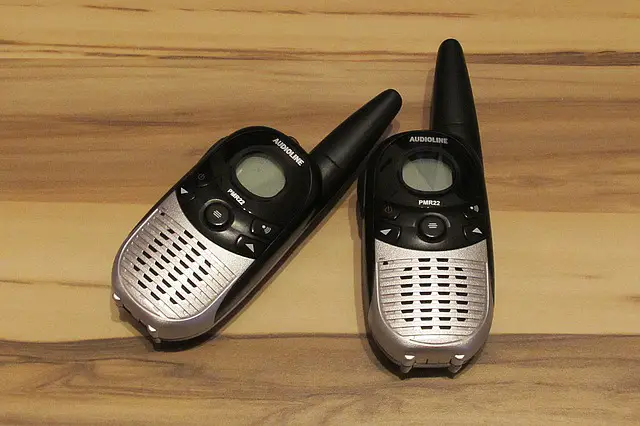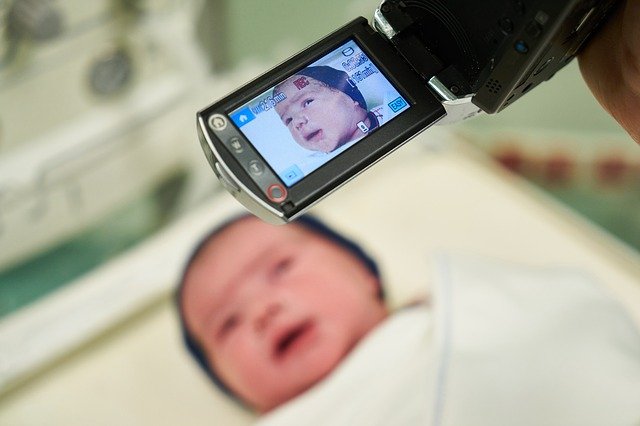Are you thinking of buying a digital baby monitor? Perhaps you want to choose between analog vs Digital Baby Monitor.
In any case, you’ve come to the right place. In this guide, we will discuss:
- analog vs digital baby monitor – main differences between analog and digital baby monitors
- Tips to help you decide the type of baby monitor is right for you
- And more…
Analog vs Digital Baby Monitor
Analog vs Digital Baby Monitor has several differences. The main difference is that a digital baby monitor uses an encrypted digital signal which is then decrypted when received. This greatly reduces interference issues that are seen in analog baby monitors.
Analog vs Digital Baby Monitor – The Lowdown

Parents have two choices before them as far as baby monitors are concerned: analog and digital. Each type has benefits and disadvantages and an informed parent needs to know them both. This can help you make the right choice for your child.
The main advantage of digital baby monitors is that they use encryption technology and transmit the encrypted signal over a wireless network. This encryption feature makes them more secure than analog baby monitors which are susceptible to being hacked.
Digital technology also greatly reduces issues like signal interference. Modern digital baby monitors transmit signals on a lower frequency band to reduce unwanted radiation thereby protecting your baby.
On the downside, digital baby monitors are slightly more expensive than analog ones. Rightfully so, because you get many features.
Analog vs Digital Baby Monitor – Main Differences
The classic analog baby monitor
A classic analog baby monitor works just like a radio. It comes with a parent unit and a baby unit. You place the parent unit in your bedroom and the baby unit in the nursery. The baby unit transmits a signal (audio or video) on a 49 MHz frequency band.
You have the freedom to set up the transmission on both units which is why you are more likely to pick up sounds from the adjacent/neighbor’s home or even interference from your own microwave devices or cordless phones. The signal can also be picked up by hackers. Also, the range of these monitors is less – between 50m (indoors) and 400 m (outdoors).
Classic analog monitors only transmit sound and not images, so you cannot see your baby. On the positive side, they can keep your baby free from unwanted radiation.
Digital baby monitor and DECT baby monitor
Modern digital baby monitors use the DECT or Digital Enhanced Cordless Technology. This is more secure compared to the earlier digital monitors because they use advanced features like the FHSS spread spectrum. This ensures that no one else can hear your baby.
The main difference between analog vs digital baby monitor is that the digital ones use a different frequency (2.4 Mhz) as against the 49 MHz used by analog monitors.
Thanks to the use of several modern technology features, digital/DECT baby monitors are safer and more secure from hacking compared to analog monitors.
A primary concern about digital baby monitors is their radiation. However, manufacturers are now eliminating this issue with the ECO-DECT version. ECO DECT emits a signal which is lower in radiation and that makes the monitor very safe for your baby.
The range of transmission for DECT monitors is between 50 meters (indoors) and 300 meters (outdoors).
Here is a summary of differences between analog vs digital Baby monitors:

Analog vs Digital Baby Monitor – Differences
| Feature | Analog Baby Monitor | Digital Baby Monitor |
| Technology | Use electromagnetic waves to transmit sound between baby and parent unit. You can have 1.9 GHz and 2.4 GHz, bands. The 1.9 GHz band could reduce the risk of interference. | Use the DECT or FHSS technology to transmit signals. The frequency used is 2.4 Mhz which is encrypted and then decrypted. |
| Price | Start from $20 | Between $50 and $500 |
| Safety from hackers | More susceptible to being hacked. | Less susceptible to being hacked |
| Susceptibility to signal interference | Because you set up a transmission channel to receive and transmit a signal, the chances of signal interference are high. You might hear a neighboring baby on it. As mentioned earlier, choose a 1.9 GHz band that can minimize interference. | Very low because of lower signal frequency. |
| Range of coverage | 400 meters outdoors and 50 meters indoors. PMR analog baby monitors have a wider range of about 3km. | 50 m indoors and about 300m outdoors. |
| Radiation exposure | Free from radiation and protect baby from unwanted radiation | Do have radiation but you can opt for an ECO-DECT monitor. These work at a lower signal frequency and can minimize radiation exposure. |
| Video function | Classic analog baby monitors are capable of transmitting sound only. Modern ones can transmit video too. | Can have video and audio both. Could also take baby’s vitals like breathing, heart rate, etc. |
Analog vs. Digital Baby Monitor: Which is Right For Me?
Even the savviest of parents face a dilemma when it comes to buying baby monitors. After all, it can be tricky balancing features, safety, and price all at once.
Here are some factors that can help you decide which baby monitor is right for you. In the subsequent sections, we have even highlighted in detail whether a digital monitor will be better for you or an analog one.
1. Features
- Do you want a basic monitor with just the audio feature? Or do you wish to see your baby- which means a video function as well?
- What is the range of the monitor?
- Does the monitor also detect vitals of the baby like breathing, heart rate, etc? If you have a sick baby, then these may be important.
- Does its receiver light up instead of simply making sounds like beeps/alerts – in case you do noisy tasks like washing utensils/vacuuming?
2. The size of your home
If you have a very large house with concrete walls, you could run into various reception issues. Take into account the weather too – if you live in a cold place, you might prefer keeping your bedroom doors closed. That is why you need a reliable monitor that alerts you to the baby’s crying through closed doors.
3. Portability
If you want to carry the monitor around as you do your yard work or laundry, then select one that is lightweight and can be carried around with ease.
4. Battery life
The advantage of monitors with batteries is that you eliminate dangerous cords which can be a hazard once your baby learns to stand up in the crib and pull cords. However, you need to look for one that has a longer battery life and does not need frequent charging.
5. Availability of the Internet
These days, baby monitors can work on 3G/4G/5G networks. So you need reliable Internet. You can even link them to your SmartPhone via a mobile application. However, do remember that you won’t be able to use the monitor should you happen to be in a remote area without Internet connectivity.
6. Number of receivers
If you want to see your baby from the laundry room, yard, or anywhere in the house, look for a monitor that lets you add several receivers.
What Is A DECT (Digital Enhanced Cordless Technology) Baby Monitor?

DECT stands for Digital Enhanced Cordless Technology. Any device that gives long-range reception without any cord is DECT.
A DECT baby monitor works on the 1.9 GHz frequency. Since very few devices work on this lower range, they are virtually free from interference.
The major concern about DECT baby monitors was that they give off harmful radiation. However, the newer ECO DECT standard has eliminated this issue.
Here are the benefits of DECT baby monitors:
- No interference from other baby monitors, microwaves, devices
- Option of corded and cordless
- Long-range of about 300 m outdoors and 50 m indoors
- Sound-activated LED lights to help you see at night
- Volume control.
- Different alert tones for low battery indication, etc.
- Easy to use.
- Rechargeable batteries.
Who Is An Analog Baby Monitor Suitable For?

Choose an analog baby monitor if you are:
#1. Price-conscious
If budget is a concern, then an analog baby monitor may be more suitable for you. Most analog monitors are available at starting price of $20. However, the lower price means that you may have to compromise on certain features such as audio quality, lack of video signals, and also limited range and features as well as fewer channels.
#2. Live in a small apartment
Analog baby monitors are more suitable for smaller apartments as they have a limited range indoors. If you wish to hear your baby in the yard or a grocery store nearby, then you may be better off with a DECT or digital baby monitor.
#3. Only need audio transmission
Classic analog baby monitors only make beeps and alerts when your baby cries or makes any noise. If you wish to see your child on a monitor and ensure that it does not need attending to, then you may want to go the digital route. However, if you simply want to know if your child is up and crying, then an analog monitor will easily suit your needs.
#4. Want minimum radiation effects
Many parents choose analog baby monitors over digital to reduce the effects of radiation on their babies. Since analog monitors work on lower frequency bands, their effects of radiation are minimal compared to ones that work on higher frequency bands.
When you are in the market for a monitor, always check its frequency band of operation. A 40 Mhz band analog monitor would be a lot safer than the one operating at 2.4 GHz. Note that lower frequency band operation could mean that some audio features may be compromised. To explain simply, a 2.4 GHz monitor will be more clear in transmitting sound than the 40 Mhz one.
Who Is A Digital Baby Monitor Suitable For?
Choose a digital or DECT baby monitor if you are:
#1. Willing to spend more
If budget isn’t a concern, then a digital baby monitor could be right for you. Based on the features they offer, you can get digital baby monitors starting from $50 to $500. The higher the price, the more features you get.
#2. Live in a large house
To ensure peace of mind and have the assurance that you can hear your baby on any floor of your house or in the yard, a digital monitor would be a better choice. Digital baby monitors have a wider range and are also more sensitive.
You can also buy monitors that are compliant with SmartPhone apps that can help you listen to your child from anywhere in the house and even the yard. Some even come with 2-way communication so you can soothe and sing to your baby. Many DECT monitors come with sound-tracking activities that let you know when your baby is quiet and when it is sleeping.
#3. Need the video function
Parents who wish to see their baby and ensure its well-being will benefit from the video feature of digital monitors. Some monitors can even be synced with the SmartPhone via an app so you can hear and see your baby even at work. Many even feature night vision so you can see the grayscale infrared images in a dark nursery.
#4. When you want the least signal interference and safety from hackers
If the last thing you want is to pick up signals from neighboring babies or your own microwave devices, then opt for the DECT monitor. These days, digital baby monitors use advanced FHSS (Frequency-hopping spread spectrum) which reduces interference, prevents eavesdropping, and other common issues seen in analog baby monitors. FHSS digital baby monitors work on the 2.4 GHz band and are also virtually hack-free.
#5. More buying options
If you visit top retail sites, you might find that there are very few manufacturers selling analog baby monitors. On the other hand, you will find tons of options in digital monitors. The popularity of digital monitors is on the rise, especially DECT monitors. Resultantly, manufacturers are also coming up with more and more innovative features in them. Parents are spoiled for choice when it comes to digital baby monitors. So, if you want more options, greater features, and several top brand names to choose from, then digital is the way to go.
